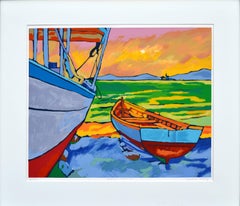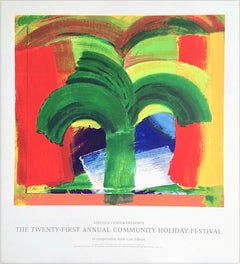Guido Lopez Art
to
2
2
2
2
Overall Height
to
Overall Width
to
2
1
1
1
2
2
6,996
3,377
2,513
1,212
2
Artist: Guido Lopez
Calle De La Ermita, Valencia Spain
By Guido Lopez
Located in Soquel, CA
Bright and bold screen print by Spanish artist Guido Lopez (Spain, 20th century). Signed and titled, "Guido Lopez", 12/150. Unframed. Image 22.5"H x 25"L, Mat 31"H x 34.25"L.
Category
Early 2000s Modern Guido Lopez Art
Materials
Screen
Poezia Marina, Spain - Abstract Landscape
By Guido Lopez
Located in Soquel, CA
Bright and bold screen print by Spanish artist Guido Lopez (Spain, 20th century). Titled "Poezia Marina", signed lower right "Guido Lopez', 12/150. Unframed. Image 22.5"H x 25"L, Mat...
Category
Early 2000s Modern Guido Lopez Art
Materials
Screen
Related Items
IN TANGIER Limited Edition Serigraph, Art Poster, Abstract Palm Tree Morocco
By Howard Hodgkin
Located in Union City, NJ
Howard Hodgkin (1932-2017), one of Britain’s greatest contemporary artists became best known for his vibrantly colored paintings that chronicle his personal experiences. IN TANGIER...
Category
1990s Abstract Guido Lopez Art
Materials
Screen
Frankenthaler, Solar Imp 2001, Lincoln Center New York City Ballet
By Helen Frankenthaler
Located in Fairfield, CT
Artist: After Helen Frankenthaler (1928-2011)
Title: Solar Imp (Lincoln Center Salute’s the New York City Ballet)
Year: 2001
Medium: Silkscreen poster on extra thick Somerset paper
E...
Category
Early 2000s Abstract Expressionist Guido Lopez Art
Materials
Screen
Beauty & Flowers, Tie Feng Jiang
By Tie Feng Jiang
Located in Fairfield, CT
Artist: Jiang Tie-Feng (1938)
Title: Beauty & Flowers
Year: 1994
Medium: Silkscreen on Vellum Rag paper
Edition: 269/300, plus proofs
Size: 43 x 31.25 inches
Condition: Good
Inscript...
Category
1980s Pop Art Guido Lopez Art
Materials
Screen
Original "Wagon Lits" pop art style serigraph travel by train poster
By Valerio Adami
Located in Spokane, WA
Original “Wagon Lits” serigraph poster by the artist Valerio Adami.
It was printed in France by GrafiCaza (Michel Caza), one of the finest serigraph companies on woven paper—in exce...
Category
1990s American Modern Guido Lopez Art
Materials
Screen
H 36 in W 24 in D 0.05 in
Modernist Silkscreen Screenprint 'El Station, Interior' NYC Subway, WPA Artist
By Anthony Velonis
Located in Surfside, FL
screenprint printed in color ink on wove paper. New York City subway station interior.
Anthony Velonis (1911 – 1997) was an American painter and designer born in New York City who helped introduce the public to silkscreen printing in the early 20th century.
While employed under the federal Works Progress Administration, WPA during the Great Depression, Velonis brought the use of silkscreen printing as a fine art form, referred to as the "serigraph," into the mainstream. By his own request, he was not publicly credited for coining the term.
He experimented and mastered techniques to print on a wide variety of materials, such as glass, plastics, and metal, thereby expanding the field. In the mid to late 20th century, the silkscreen technique became popular among other artists such as Robert Rauschenberg and Andy Warhol.
Velonis was born into a relatively poor background of a Greek immigrant family and grew up in the tenements of New York City. Early on, he took creative inspiration from figures in his life such as his grandfather, an immigrant from the mountains in Greece, who was "an ecclesiastical painter, on Byzantine style." Velonis attended James Monroe High School in The Bronx, where he took on minor artistic roles such as the illustration of his high school yearbook. He eventually received a scholarship to the NYU College of Fine Arts, into which he was both surprised and ecstatic to have been admitted. Around this time he took to painting, watercolor, and sculpture, as well as various other art forms, hoping to find a niche that fit. He attended NYU until 1929, when the Great Depression started in the United States after the stock market crash.
Around the year 1932, Velonis became interested in silk screen, together with fellow artist Fritz Brosius, and decided to investigate the practice. Working in his brother's sign shop, Velonis was able to master the silkscreen process. He reminisced in an interview three decades later that doing so was "plenty of fun," and that a lot of technology can be discovered through hard work, more so if it is worked on "little by little."
Velonis was hired by Mayor LaGuardia in 1934 to promote the work of New York's city government via posters publicizing city projects. One such project required him to go on a commercial fishing trip to locations including New Bedford and Nantucket for a fortnight, where he primarily took photographs and notes, and made sketches. Afterward, for a period of roughly six months, he was occupied with creating paintings from these records. During this trip, Velonis developed true respect and affinity for the fishermen with whom he traveled, "the relatively uneducated person," in his words.
Following this, Velonis began work with the Public Works of Art Project (PWAP), an offshoot of the Civil Works Administration (CWA), where he was assigned to serve the different city departments of New York. After the formation of the federal Works Progress Administration, which hired artists and sponsored projects in the arts, he also worked in theater.
Velonis began working for the federal WPA in 1935. He kept this position until 1936 or 1938, at which point he began working in the graphic art division of the Federal Art Project, which he ultimately led. Under various elements of the WPA program, many young artists, writers and actors gained employment that helped them survive during the Depression, as well as contributing works that created an artistic legacy for the country.
When interviewed in December 1994 by the Library of Congress about his time in the WPA, Velonis reflected that he had greatly enjoyed that period, saying that he liked the "excitement" and "meeting all the other artists with different points of view." He also said in a later interview that "the contact and the dialogue with all those artists and the work that took place was just invaluable." Among the young artists he hired was Edmond Casarella, who later developed an innovative technique using layered cardboard for woodcuts.
Velonis introduced silkscreen printing to the Poster Division of the WPA. As he recalled in a 1965 interview: "I suggested that the Poster division would be a lot more productive and useful if they had an auxiliary screen printing project that worked along with them. And apparently this was very favorably received..."
As a member of the Federal Art Project, a subdivision of the WPA, Velonis later approached the Public Use of Arts Committee (PUAC) for help in "propagandizing for art in the parks, in the subways, et cetera." Since the Federal Art Project could not be "self-promoting," an outside organization was required to advertise their art more extensively. During his employment with the Federal Art Project, Velonis created nine silkscreen posters for the federal government.
Around 1937-1939 Velonis wrote a pamphlet titled "Technical Problems of the Artist: Technique of the Silkscreen Process," which was distributed to art centers run by the WPA around the country. It was considered very influential in encouraging artists to try this relatively inexpensive technique and stimulated printmaking across the country.
In 1939, Velonis founded the Creative Printmakers Group, along with three others, including Hyman Warsager. They printed both their own works and those of other artists in their facility. This was considered the most important silkscreen shop of the period.
The next year, Velonis founded the National Serigraph Society. It started out with relatively small commercial projects, such as "rather fancy" Christmas cards that were sold to many of the upscale Fifth Avenue shops...
Category
1980s American Modern Guido Lopez Art
Materials
Screen
'Serving Poi', Hawaii, NYMoMA, Metropolitan Museum, National Gallery, SFAA, GGIE
By Marion Osborn Cunningham
Located in Santa Cruz, CA
Stamped, verso, with certification of authenticity for 'Marion Cunningham' (American, 1908-1948) and created in 1948.
Paper dimensions: 17.75 x 16 inches
A substantial and rare, mid-century silkscreen showing a Hawaiian family seated beneath a traditional tent of tapa cloth and being served poi by a young woman. To realize this complex work, Cunningham used as many as one dozen hand-drawn screens, each of which varied in pigment, hue and opacity. Created during the extraordinary creative ferment that characterized the last year of the artist's life, this work represents a remarkable achievement for both artist and medium.
Born in Indiana, Marion Osborn Cunningham moved to California in 1911. She first studied art with the American Impressionist, Ruth Heil Emerson, before continuing her education at Santa Barbara City College and receiving her Bachelor of Arts from Stanford University. She subsequently furthered her studies at the California School of the Fine Arts and at the Art Students League in New York City, where she met and married the American abstract artist Ben Cunningham. Returning to San Francisco...
Category
1940s Modern Guido Lopez Art
Materials
Screen, Paper
Conferring Blue, Julian Stanczak
By Julian Stanczak
Located in Fairfield, CT
Artist: Julian Stanczak (1928-2017)
Title: Conferring Blue
Year: 1979
Edition: 66/175, plus proofs
Medium: Silkscreen on Somerset paper
Size: 25 x 25 inches
Condition: Good
Inscripti...
Category
1970s Op Art Guido Lopez Art
Materials
Screen
Baloo Baba, Peter Max
By Peter Max
Located in Fairfield, CT
Artist: Peter Max (1937)
Title: Baloo Baba
Year: 1972
Edition: 300, plus proofs
Medium: Silkscreen on wove paper
Size: 16 x 18 inches
Condition: Excellent
Inscription: Signed by the ...
Category
1970s Pop Art Guido Lopez Art
Materials
Screen
Pink Vegetal Pool - Trees, Swimming Pool
Located in AIX-EN-PROVENCE, FR
silkscreen Two colours on Fine Art paper. Interior Photography, Romantic, Abandoned place, Nature, Window
Work Title : Piscine Végétale Rose
Artist : Marie Vandooren...
Category
21st Century and Contemporary Contemporary Guido Lopez Art
Materials
Screen, Archival Paper
Vega Blue, Victor Vasarely
By Victor Vasarely
Located in Fairfield, CT
Artist: Victor Vasarely (1908-1997)
Title: Vega Blue
Year: Circa 1982
Medium: Silkscreen on Arches paper
Edition: 190/300, plus proofs
Size: 30 x 22 inches
Condition: Good
Inscriptio...
Category
1980s Op Art Guido Lopez Art
Materials
Screen
Harry Shokler, Island Harbor
By Harry Shokler
Located in New York, NY
Harry Shokler used serigraphy to great advantage in this landscape. It's colorful and detailed.
It is signed in the image at the lower left. When printmakers began making serigraphs...
Category
1940s American Modern Guido Lopez Art
Materials
Screen
Amsterdam, 1973 Silkscreen by Risaburo Kimura
By Risaburo Kimura
Located in Long Island City, NY
Artist: Risaburo Kimura, Japanese (1924 - )
Title: Amsterdam
Year: 1973
Medium: Silkscreen on BFK Rives, Signed, titled and numbered in pencil
Edition: 250, AP 20
Size: 30 in. x 22 i...
Category
1970s Abstract Impressionist Guido Lopez Art
Materials
Screen
Guido Lopez art for sale on 1stDibs.
Find a wide variety of authentic Guido Lopez art available for sale on 1stDibs. You can also browse by medium to find art by Guido Lopez in screen print and more. Much of the original work by this artist or collective was created during the 21st century and contemporary and is mostly associated with the modern style. Not every interior allows for large Guido Lopez art, so small editions measuring 35 inches across are available. Customers who are interested in this artist might also find the work of Felix de Weldon , Eduardo Arroyo, and Virgilio Guidi. Guido Lopez art prices can differ depending upon medium, time period and other attributes. On 1stDibs, the price for these items starts at $860 and tops out at $955, while the average work can sell for $908.



